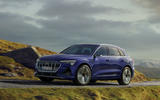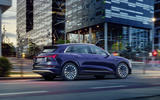Audi has upgraded its Audi E-tron electric SUV to offer 15.5 miles of additional range through modifications to the braking system and drivetrain.
The upgrade means the range-topping E-tron 55 quattro can now travel 270.9 miles on the WLTP test cycle from a single charge, 20 more than the rival Mercedes-Benz EQC.
The upgrades are taken from the new E-tron Sportback, which was revealed earlier this month in Los Angeles. They include a reworked regenerative braking system that reduces residual brake torque - essentially friction caused by the proximity of the callipers to the discs - and the ability for the front electric motor to disconnect entirely from the power supply in normal running mode.
Plus, the adjustable regenerative braking is said to now offer greater distinction between the three modes, which Audi claims will offer drivers “a more pronounced ‘one-pedal feeling’”.
Audi also says that a reworked cooling system places less strain on the pump and that a function that harnesses waste heat from the battery packs to warm the interior could boost range by as much as 10%.
Alongside the technical tweaks, Audi introduced S line trim for the E-tron. This comes with 20in alloy wheels, air suspension, colour-coded trim elements and bumper styling influenced by Audi Sport models. A prominent spoiler and diffuser at the rear set the S line apart from other E-tron variants.
All E-tron 55 quattro models will feature the new upgrades, but the model’s €80,900 entry-level price in Germany is unchanged. UK pricing and delivery details are yet to be confirmed, but we expect the starting price to remain at £70,845.
The entry-level E-tron 50, revealed earlier this year with a shorter range, doesn't benefit from the updates.
Read more
Audi E-tron Sportback revealed as electric coupe SUV
Audi E-tron 50 revealed as value version of flagship EV
Audi E-tron 55 quattro 2019 long-term review













Join the debate
Add your comment
Battery range up scaling
Jaguar have also increased their range with a software update, they've discovered that the batteries are performing better than expected so they've made more of the existing battery available. This could happen to more EVs as the battery performance is monitored.
Quick math
The E-tron was previously advertised at 239 miles(WLTP) of range and they have added 15.5 miles which means it now apparently has 270.9 miles. The EQC is 259 miles(WLTP) which is apparently 20 miles less than the E-tron's 270.9. Excuse me while a small trickle of blood drips from my ear
200 odd miles in real world
200 odd miles in real world driving for 70k plus?
Nah...
Rediculous
lambo58 wrote:
From a technology stand point Audi/VAG are behind Tesla/Hyundi on a range and range/cost basis.
However my arguement was more that requirements for a 300 mile range are more based on a public perception error than how people actually use their cars.
Tesla's choice to build a car that works with peoples perceptions rather than try to convince people they only need 100-150 miles of range, then to target those cars at people who could afford 200-300 miles of batteries (sports cars and luxary saloons) was strategic/marketing genius.